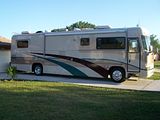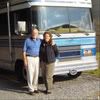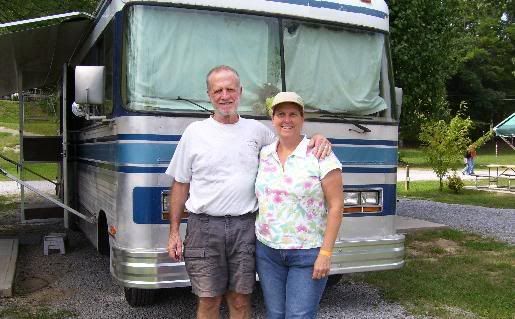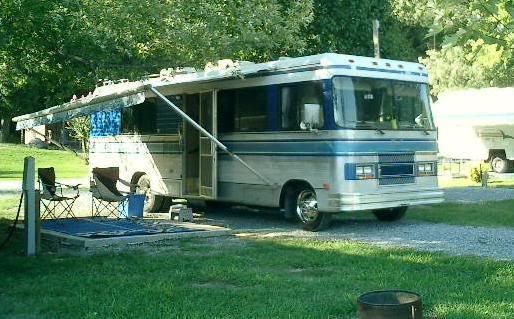Go to...  | Start A New Topic  | Search  | Notify  | Tools  | Reply To This Topic  |  |
| First Month Member |
My major changed from engineering to business, but one of my sons is degreed as a systems engineer, and we talk on this often. He is really into alternate energy sources, etc. In one discussion, he said that battery technology is the Achilles heel of heavy vehicles. And storage is the same on propane or LPG. I remember in the 70s, some RVs, including Barth were propane capable. US propane prices and the storage situation have pretty killed the propane conversions. Conspiracy theorists may have a point there. Propane allows higher compression, way longer between oil changes and pollutes less. A properly built propane engine can have astounding efficiency. At work, most of our larger vehicles were propane and the smaller shorter range vehicles were electric, all to gain anti-pollution and efficiency tax credits. Good example of positive incentive by government, there. I think the propensity of so many RVers to go to pretty places to enjoy nature means hills and mountains. This means there has to be a big honkin' motor, be it fuel or electric, and if electric, a lot of heavy batteries. The only successfully working example of a heavy road vehicle with non-fossil fuel I know of is the busses in Amsterdam. They operate on a giant flywheel, which stores energy. Energy is taken from it through a clutch and transmission. The flywheel is spun up at designated stops by plugging in to nuclear-generated electricity. Sadly, my Dutch is poor, so I didn't learn as much as I would have liked. I don't think that technology would apply to a vehicle that strayed far from a spin-up station. The simple truth of nuclear power is that it is just a nifty way to boil water. The most efficient way to propel a heavy boat with hot water is by steam turbine. I presume that would apply to motor homes. However, the railroads rejected steam turbines, so maybe not. We are getting into the No Nukes and global warming fears here, so political and environmental considerations would apply. The issue of a bunch of little nuclear reactors out there is a little scary, given the care they seem to require. Navy Nuke School is reputed to be the toughest academic military training (I know one USNA Brigade Commander who flunked out), so the thought of just anybody operating or repairing one is scary. Perhaps they could be exchangable sealed units that would be fail-safe. Even if we could get away with a bunch of little nuclear reactors out there, we would have to deal with the global warming issues of putting all that heat and humidity into the atmosphere. I believe a Stirling cycle steam engine would introduce less heat into the environment than a turbine, so maybe that would be better. When I was an engineering major, I had a prof who later worked for Bill Lear on his steam car. He was fascinating on the subject. Lear used something other than water in his closed-circuit engine. He used it in a bus, which showed promise, but didn't survive initial evaluation by the California Department of Whatever. Perhaps Lear's ideas could be refined today to work in a MH. It would be neat to have him here on this discussion. However, all things Lear are controversial, and contradictions and disagreement abound. And any pressure vessel is scary. Many states require a license to operate a boiler. Some shop and industrial locomotives used compressed air instead of steam, as they were always near a recharge point. Perhaps a fuel cell could drive a compressor to make compressed air to power a motor home engine. On a more practical and immediate level, I would hope that many car drivers would switch to hybrids and electrics so we RVers can still have fuel at a reasonable price. Motorcycles and bicycles have been my daily transportation since 1957, so I feel I have earned the right to use whatever my Barth asks for. Interestingly, we just spent a week or so in Silicon Valley, and there seem to be two extremes of transportation there. Many more bicycles (not just students) and many many more SUVs, particularly big expensive ones. For some reason, they are almost all silver. I just found it curious that there were way more of each than I am used to. Both extremes of the energy consumption spectrum, as it were. I will say that the Field of Dreams dictum, "If you build it, they will come", applies there. The abundance of bicycle lanes has caused many to drop their fears of riding in traffic and get out there and pedal. Communities with lots of good bike lanes have lots of cyclists, and those with fewer have way fewer. Dining there was an experience, too. Oh, yeah, before anyone jumps on me for owning an SUV, it is powered by a teeny 4-cylinder engine with a manual trans. . 84 30T PeeThirty-Something, 502 powered | |||
|
From WSJ: The price of retail gasoline could fall by half, to around $2 a gallon, within 30 days of passage of a law to limit speculation in energy-futures markets, four energy analysts told Congress on Monday. Do you think Congress will act? | ||||
|
| First Month Member |
WWJD? Drive the money-changers out of the temple, perhaps. It would be informative to know how many members of Congress are recipients of funds and benefits from Big Oil. . 84 30T PeeThirty-Something, 502 powered | |||
|
 3/23 3/23 |
Bill, when I was a young lad working for Rusty's old employer a cohort was a steam train afficianado. Every chance he had on weekends he would take a medium format camera to the switchyards in the area and photograph every engine he could find. One of those engines was a yard engine that essentially was a large thermos bottle. The engine would be pressurized at the end of a shift and run all shift long. As I remember it was like 7 on 1 off or maybe it was two shifts and off. At any rate it hauled a bunch more than one 40 footer from a dead stop. If we could just figure which campgrounds had high pressure steam connections. | |||
|
Captain Doom |
The switchers ccctimtation refers to are the "Fireless locomotives"; they were charged from the shop steam supply. Steam turbines were impractical because reciprocating locomotives discharged the spent steam into the atmosphere (and through a veturi which helped expel the smoke from the firebox). Steam turbines use a much greater quantity of steam (hence, water), and the problem of condensing the steam to recycle the water was never solved, and consumption was too high to allow economical legs between rewaterings. Ships, of course, have the water in which they float to cool and condense the steam. Pennsy, N&W, and C&O all tried and couldn't make a practical turbine loco. Rusty '94 28' Breakaway: MilSpec AMG 6.5L TD 230HP Nelson and Chester, not-spoiled Golden Retrievers Sometimes I think we're alone in the universe, and sometimes I think we're not. In either case the idea is quite staggering. - Arthur C. Clarke It was a woman who drove me to drink, and I've been searching thirty years to find her and thank her - W. C. Fields | |||
|
| First Month Member |
Rusty, do the steam boats get their water from the salty ocean or what? How about the nuclear subs? When my oldest was at the Academy, I got on a tour of a boomer, but ended up being questioned in a room with people with guns because I asked too many questions, particularly about the missile nav systems. I had to explain (and prove my bona fides) that it was just professional curiosity, as our airliners had pretty much the same technology, and I actually taught the subject.
UP, too. However, unlike the geared Pennsy, it was really an electric locomotive powered by a steam turbine. It was the only condensing steam loco ever operated in the US. An engineering triumph, but not an operational success. But close. . 84 30T PeeThirty-Something, 502 powered | |||
|
Captain Doom |
Steam ships and steamboats in olden days, if operated in fresh water (Great Lakes, inland rivers) took their water from their surroundings, but this only worked for fire-tube boilers (which is also the usual design for reciprocating steam locos). Water-tube boilers have little tolerance for any contaminants - especially calcium and sodium compounds (like salt). One of the reasons locos and olde freshwater ships could tolerate impurities is the boiler design where a "bottom-blow" could safely be done to excrete crud; the same procedure under load on a water-tube boiler would likely cause catastrophic failure. Nuclear ships all use triple-distilled water, as the nukes have even less tolerance for impurities than fossil fuelled. While there are techniques for clearing the bottoms (the "mud drum", so named for a reason) of water-tube boilers, they can't be done while operating at the usual tempo, and shutting down a reactor is much more complicated than a fossil fuelled boiler (which consists of lowering the load to minimum and turning off the oil). I don't recall UP operating a steam turbine, but they did use two versions (one of which had a sub-version) of gas turbines (the two with 4,500 HP including the "Veranda" version, the later "Big Blow" with 8,500). The theory was that the inefficiency of the gas turbine would be ofset by the cheaper fuel (#6 @ $1.75/bbl - yes friends, that's about $0.04/gal) as opposed to #4 for the diesels at about $0.07/gal. The neat thing about the Big Blows is that, except for the Pannsy GG-1 electrics and the Milwaukee Little Joe electrics, they were the only non-steam locos to surpass the power of the C&O H-8 Alleghenies and the UP Big Boys. From the worthless facts department: Single-unit diesels have yet, 70 years later, to surpass around 20 common steam loco designs...of the 1930s - the C&O T-1 2-10-4s and 4-8-4 Greenbriers, UP 4-10-2, 4-12-2, and 4-6-6-4 (also used by D&H, D&RGW, and Clinchfield), the Pennsy 4-4-4-4, 4-6-4-4, 4-4-6-4 and 6-4-4-6, N&W 2-6-6-4 and the 4-8-4 Js, and DM&IR 2-8-8-4. Rusty '94 28' Breakaway: MilSpec AMG 6.5L TD 230HP Nelson and Chester, not-spoiled Golden Retrievers Sometimes I think we're alone in the universe, and sometimes I think we're not. In either case the idea is quite staggering. - Arthur C. Clarke It was a woman who drove me to drink, and I've been searching thirty years to find her and thank her - W. C. Fields | |||
|
| First Month Member |
Do they carry it or make it underway? What is the consumption? Do they recover some of it?
The UP effort used a steam turbine to generate electricity to power the electric motors that drove the wheels, so it might not be considered a pure steam turbine locomotive, but it is usually called a steam turbine locomotive. Just as what we call diesels are really diesel/electric. Trivia: In the 747 days, our larger airline tractors were diesel/electric. Never did get used to the throttle lag. HERE is a site that discusses the UP steam turbine locomotive a little. . 84 30T PeeThirty-Something, 502 powered | |||
|
Captain Doom |
They top off in port, then make their own underway; feed water consumption rate is classified. All but that lost to system leaks is recovered via condensation.
Interesting site - until now, I'd never heard of that loco... Rusty '94 28' Breakaway: MilSpec AMG 6.5L TD 230HP Nelson and Chester, not-spoiled Golden Retrievers Sometimes I think we're alone in the universe, and sometimes I think we're not. In either case the idea is quite staggering. - Arthur C. Clarke It was a woman who drove me to drink, and I've been searching thirty years to find her and thank her - W. C. Fields | |||
|
| First Month Member |
Don't ya just love that long Duesenberg hood? Compared to the short-nosed diesels of the era, it has a look all of its own. Another part of that site, http://www.dself.dsl.pipex.com/MUSEUM/LOCOLOCO/locoloco.htm has all sorts of interesting locos. . 84 30T PeeThirty-Something, 502 powered | |||
|
At least some Russian city buses used to be electric with a constant speed engine driven generator on board. It would be possible to build a MH using the technology. The Chevy volt uses this some technology. It has a 3 cylinder battery charger. '92 Barth Breakaway - 30' 5.9 Cummins (6B) 300+ HP 2000 Allison Front entrance | ||||
|
| First Month Member |
The first thought that occured was that a bus drives mostly level. As I mentioned earlier, RVs go up hills, requiring either a way larger generator and motor or reserve power now and then. I wonder how large a battery bank it would take and how much larger electric motor it would take to get up mountains. . 84 30T PeeThirty-Something, 502 powered | |||
|
 4/11 4/11 |
Not sure how this post changed topics, but the discussion on the hybrid cars is interesting. When I was an Engineering student we looked at a hybrid car with an electric motor, bank of batteries and a small gas powered generator to charge the batteries. It is a very, very simple design one that 20 year old engineering students studied. So 40 years later I see that Chevy and Ford are designing such a car. It is so simple that it will work really well. In addition if it is a commuting car, one that only goes to work 15 miles a way and then sits all day, solar cells on the surface would recharge most of the battery in the 8 hours of sitting, after 30 min of driving to work. But then we were kids back then, what did we know. Tom Tom Loughney Barthless.... | |||
|
Captain Doom |
Nothing new here, just a continuation of what we all knew, all along: Motorhome prices are in the pits. I've been following eBay (a benefit/curse of being retired with nothing alse to do - although I have Things To Do). On eBay, virtually NOTHING with a Reserve has sold in the past week (one Roadtrek); offers are in the 35-50% of what the seller wants, based on "Buy It Now". I wonder when dealers (the predominate players on eBay) will get the message. Rusty '94 28' Breakaway: MilSpec AMG 6.5L TD 230HP Nelson and Chester, not-spoiled Golden Retrievers Sometimes I think we're alone in the universe, and sometimes I think we're not. In either case the idea is quite staggering. - Arthur C. Clarke It was a woman who drove me to drink, and I've been searching thirty years to find her and thank her - W. C. Fields | |||
|
 6/12 6/12Formally known as "Humbojb"  |
And I wonder what the dealers are going to do with all these floor plans that must be costing them a fortune every month. I would suspect that there will be a lot of dealers that just go under and only the ones with deep pockets will survive. Or do you thing the manufacturers will protect the dealers in some way?
| ||||||||||||
|
| Powered by Social Strata | Page 1 2 3 4 |
| Please Wait. Your request is being processed... |
|
This website is dedicated to the Barth Custom Coach, their owners and those who admire this American made, quality crafted, motor coach.
We are committed to the history, preservation and restoration of the Barth Custom Coach.
We are committed to the history, preservation and restoration of the Barth Custom Coach.

